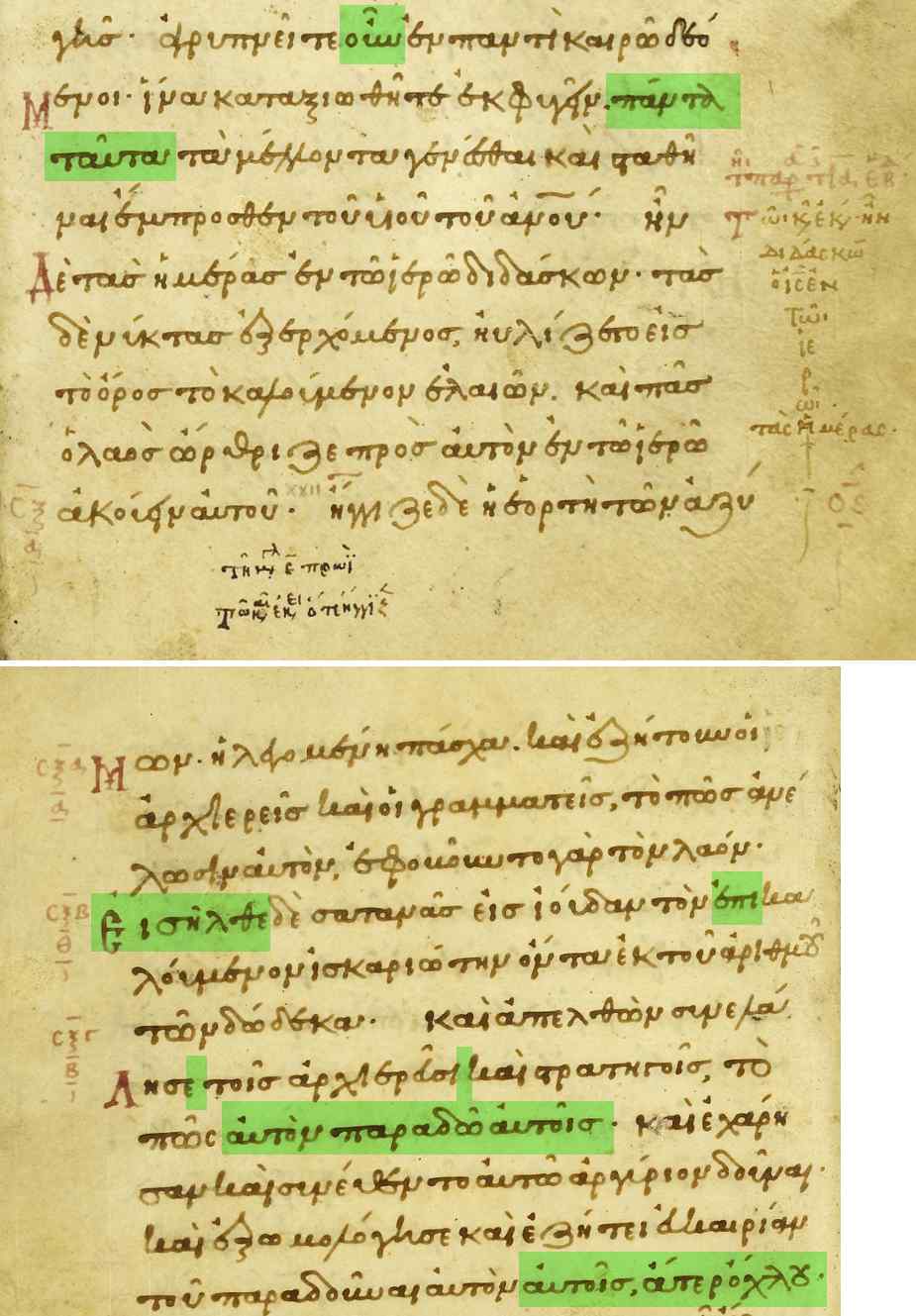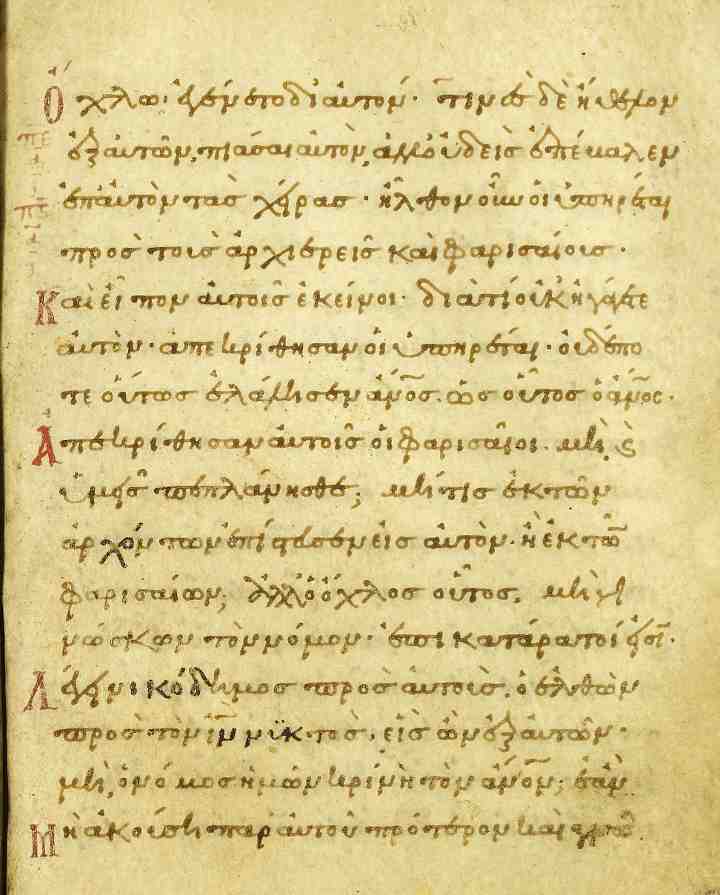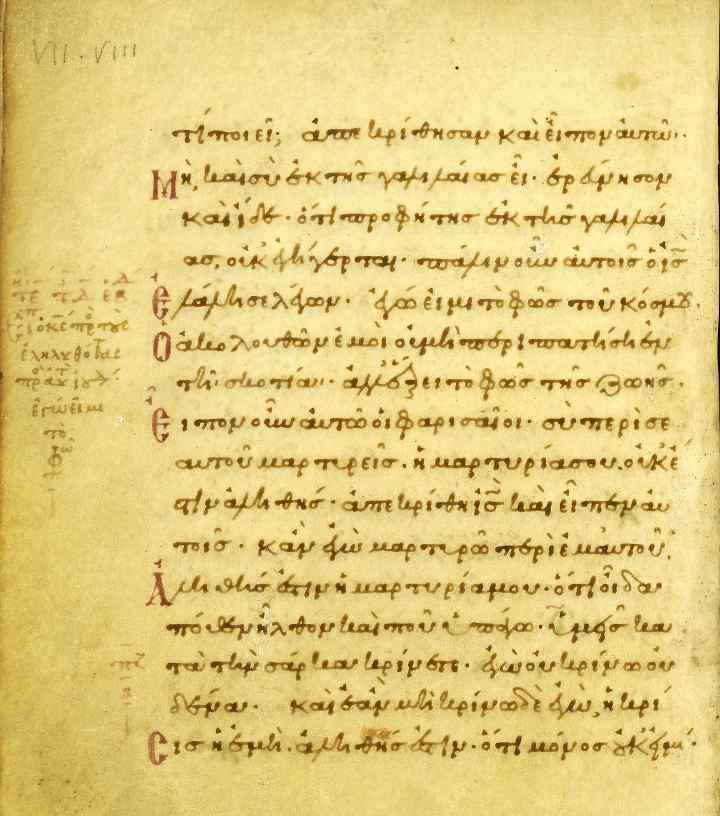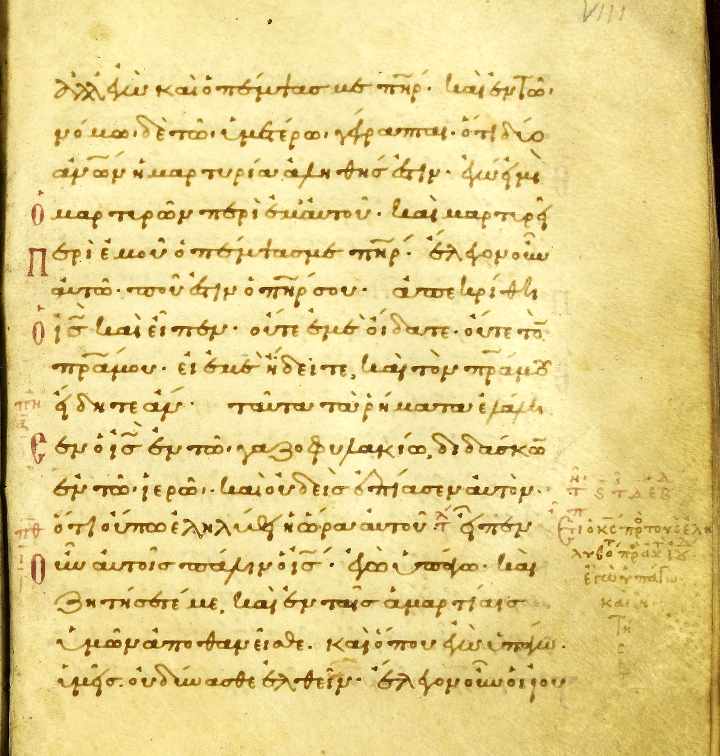
Last Updated: May 27, 2010 |
MS GA-713Photos & Text from Cursive MS GA-713, Algerina Peckover 561, (11th-12th cent.) |

Last Updated: May 27, 2010 |
MS GA-713Photos & Text from Cursive MS GA-713, Algerina Peckover 561, (11th-12th cent.) |
MS GA-713: - Algerina Peckover 561 (11th-12th cent.)
Introduction - Manuscript description
Photos & Text:
Luke 21:36-22:6 - Photo
Luke 21:36-22:6 - Text and notes
Folio 310r John 7:34-7:52 - text leading up to PA
Folio 310v Jn 7:52/8:12 fwd - omission of PA
Folio 311r Jn 8:16 fwd - text following om.
Background
Birmingham, Selly Oak College Codex Algerina Peckover Greek 7.
von Soden's e351; Scrivener's 561e.
Contains the Gospels with mutilations (lacking, according to Scrivener, Matt. 27:43-44, John 7:53-8:11 (omitted), 10:27-11:14, 11:29-42).
(Also has some palimpsest leaves of an uncial lectionary, formerly 43apl though now deleted from the catalog.)
Date:
Variously dated; Scrivener says the 11th century "or a little later"; von Soden lists it as 13th century; The Kurzgefasste Liste suggests the 12th.
Scrivener describes it as having the Ferrar (f13) text, but it appears to be Alexandrian in Luke, and more Byzantine in John.
Folio 267: Luke 21-22
pg. 267 recto (front, bottom) and verso (top reverse side), showing Luke 21:36-22:6 inclusive.
Typically manuscripts containing the four Gospels have been copied from early exemplars that originally bundled them together from various independant sources (transmission lines). Thus the type of text in one Gospel gives no indication of what is in the others, and no generalization is possible. Each Gospel must be examined individually.
Here the text-type of Luke is easily identified as essentially that of Codex Alexandrinus (A, 4th cent.). Its many ancient readings are shared uniquely with both Cod. A and the Byzantine text-type, while diverging from the "א/B" text-type. These have been highlighted in green on the photo below.
Although this manuscript of the 4 Gospels was classed as of the "Family 13" text-type by F.H.A. Scrivener (c.1870s), this was probably based on the readings he found in other Gospels. Here Luke 21:38 ends and 22:1 begins consecutively on the last line of the bottom of the first page, separated by a typical "dot & space".
Family 13 manuscripts typically insert the Pericope de Adultera (John 7:53-8:11) at this point in Luke, and its absence along with Codex A readings indicates that for Luke at least, MS 713 is not really Family 13 at all. Additionally, the purely Lukan form of verses 37-38 also indicate the PA never stood here in MS 713's exemplar. Typically these verses were modified to accomodate the PA and avoid duplication of expressions found in Jn 7:53-8:1. Note especially the uniquely Lukan form of the Mount of Olives: το ορος το καλουμενον ελαιων - "the mount called 'of Olives' ".
Others have classed MS 713 as "Byzantine/mixed", but this too gives the misleading impression that its text is late, when in fact its text has consistently ancient readings conforming closely to the "Alexandrinus" (A) text-type.

verso
21:36 αγρυπνειτε ουν
1
εν παντι καιρω δεο-
-μενοι ινα καταξιωθητε εκφυγειν παντα
ταυτα
2
τα μελλοντα γινεσθαι και σταθη-
-ναι εμπροσθεν του υιου του αν[θρωπ]ου.
3
37 ην
δε τας ημερας εν τω ιερω διδασκων τας
δε νυκτας εξερχομενος ηυλιζετο εις
το ορος το καλουμενον ελαιων. 38 και πας
ο λαος ωρθριζεν προς αυτον εν τω ιερω
ακουειν αυτου 22:1 ηγγιζεν δε η εορτη των αζυ-
recto
-μων η λεγομενη πασχα 2 και εζητουν οι
αρχιερεις και οι γραμματεις το πως ανε-
-λωσιν αυτον εφοβουντο γαρ τον λαον
3 εισηλθεν δε σατανας εις ιουδαν τον επικα-
-λουμενον ισκαριωτην οντα εκ του αριθμου
των δωδεκα 4 και απελθων συνελα-
-λησε[ν]
4
τοις αρχιερευσι[ν] και στρατηγοις το
πως αυτον παραδω αυτοις.
5
5 και εχαρη-
-σαν και συνεθεντο αυτω αργυριον δουναι
6 και εξωμολογησεν και εζητει ευκαιριαν
του παραδουναι αυτον αυτοις ατερ οχλου
6
Textual Footnotes:
1. MS 713 reads ουν along with A C Maj, against δε א/B.
2. MS 713 reads παντα ταυτα along with A C*; א along with Maj drops ταυτα through a short but obvious homoioteleuton eye-skip, while B also skips, this time dropping παντα, but reinserts παντα after ταυτα, without erasing it, reversing the order.
3. 713 directly copies the ancient contraction for ανθρωπου.
4. The early, still "malleable" ν, missing as per Codex A and many 4th cent. Uncials.
5. 713 follows Codex A here along with Maj, against a 321 W.O.R. by א/B.
6. A '231' W.O.R. is offered by א/B: Who made the original blunder is moot. 713 follows Maj, which must have been the reading of his exemplar. No corrections were made.
Summary: MS 713 offers no early evidence whatsoever for the insertion of the PA here by Family 13. Instead it offers strong and credible early support for the standard text of Luke without any insertions.
Folio 310 recto (front pg)

Folio 310 verso (reverse)
John 7:52 ends midway across line 4. Verse 8:12 begins on same line after the typical "dot & space" which separates the previous and following sections in manuscripts prepared for public church services, that leave out the PA (Jn 7:53-8:11).

Folio 311 recto (front pg)

![]()
